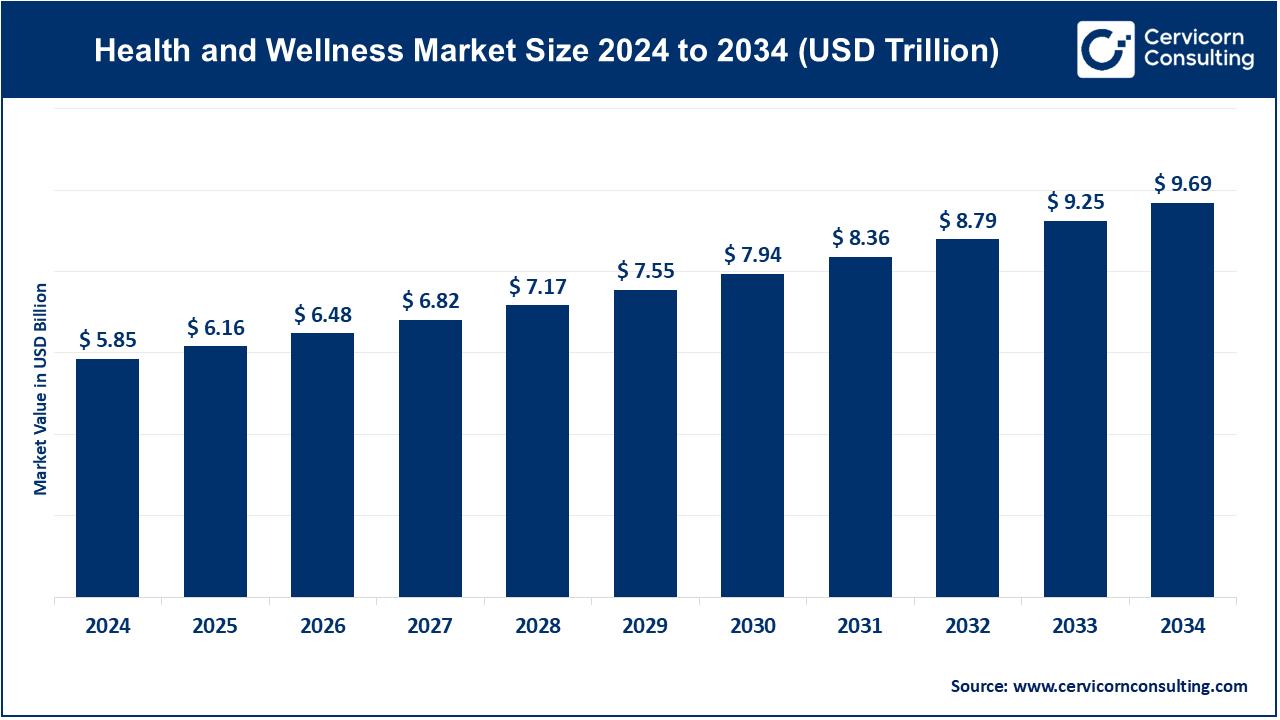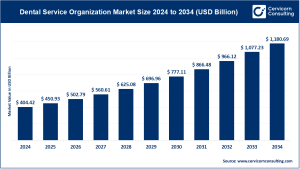Health and Wellness Market Size
In 2024, the health and wellness market was valued at USD 5.85 trillion and is projected to reach USD 9.69 trillion by 2034, growing at a CAGR of 5.17% from 2025 to 2034.
What is the Health and Wellness Market?
The Health and Wellness Market encompasses a wide array of products, services, and practices aimed at promoting physical, mental, and emotional well-being. It goes beyond the mere absence of disease, focusing on holistic health that includes balanced nutrition, regular physical activity, mental health care, stress management, and preventive healthcare.
Key components of this market include:
-
Personal Care & Beauty & Anti-Aging
-
Nutrition & Weight Loss
-
Physical Activity
-
Wellness Tourism
-
Preventive & Personalized Medicine
-
Spa Economy
As consumers become more health-conscious, there’s a noticeable shift towards preventive measures and lifestyle management rather than just treating illnesses. This evolving mindset is driving the growth of the health and wellness sector.
Market Trends
1. Digital Health Transformation
The integration of technology into healthcare is revolutionizing the industry. Wearable devices, mobile health applications, and telemedicine are enabling consumers to monitor their health in real-time, leading to more personalized and proactive care.
2. Rise of Wellness Tourism
Consumers are seeking destinations that offer health-focused experiences, such as spa retreats, yoga centers, and detox programs. This trend is fueling the growth of wellness tourism, with travelers prioritizing health and relaxation.
3. Personalized Nutrition
Advancements in genomics and biotechnology are paving the way for personalized nutrition plans tailored to individual genetic profiles, lifestyle, and health conditions, enhancing the effectiveness of dietary interventions.
4. Mental Health Awareness
There’s a growing recognition of the importance of mental well-being. Services like therapy, meditation apps, and stress management solutions are gaining popularity, reflecting a shift towards comprehensive health that includes mental health.
5. Sustainable and Clean Label Products
Consumers are increasingly demanding transparency in product ingredients. Brands are responding by offering clean label products free from artificial additives and preservatives, aligning with the growing preference for natural and organic options.
Market Dynamics
Drivers
-
Increased Health Consciousness: Consumers are becoming more aware of the impact of lifestyle choices on health, leading to greater demand for wellness products and services.
-
Technological Advancements: Innovations in digital health tools and personalized medicine are enhancing the accessibility and effectiveness of wellness solutions.
-
Aging Population: The growing elderly population is driving demand for products and services that promote healthy aging and chronic disease management.
-
Corporate Wellness Programs: Employers are investing in employee well-being programs to enhance productivity and reduce healthcare costs, contributing to market growth.
Restraints
-
Regulatory Hurdles: Navigating the complex regulatory landscape for health products can be challenging for companies.
-
Market Fragmentation: The vast array of wellness products and services can overwhelm consumers, making it difficult to identify credible options.
Opportunities
-
Innovation in Personalized Solutions: There’s a significant opportunity for companies to develop personalized health and wellness solutions leveraging technology.
-
Expansion in Emerging Markets: Tapping into emerging markets with growing middle-class populations presents substantial growth potential.
Challenges
-
Consumer Skepticism: Despite the growth, some consumers remain skeptical about the efficacy of certain wellness products and services.
-
Data Privacy Concerns: With the rise of digital health tools, ensuring the privacy and security of personal health data is paramount.
Regional Analysis
North America
Dominates the market with advanced healthcare infrastructure and high consumer spending on wellness products. The U.S. health and wellness market was valued at USD 1.41 trillion in 2024 and is expected to reach USD 2.34 trillion by 2034, growing at a CAGR of 5.19%.
Europe
Experiences steady growth, driven by increasing health awareness and government initiatives promoting preventive healthcare. The European market is characterized by a strong emphasis on sustainable and organic products.
Asia-Pacific
Exhibits rapid growth due to rising disposable incomes, urbanization, and a shift towards healthier lifestyles. Countries like China and India are witnessing a surge in demand for wellness products and services.
Latin America & Middle East
Emerging markets with growing interest in wellness tourism and natural health products. The Middle East, in particular, is investing heavily in wellness infrastructure to cater to both local and international tourists.
Recent Developments
-
Technological Innovations: Companies are investing in AI and machine learning to develop personalized wellness solutions, enhancing user experience and engagement.
-
Product Launches: Brands are introducing new products that cater to the growing demand for plant-based, organic, and clean-label options.
-
Strategic Partnerships: Collaborations between tech companies and healthcare providers are facilitating the development of integrated health solutions.
-
Regulatory Changes: Governments are implementing policies to regulate wellness products, ensuring consumer safety and product efficacy.
For more detailed insights and data, you can visit the original source: Cervicorn Consulting
Read: Pharmaceutical Water Market Key Trends, Drivers, and Regional Performance


